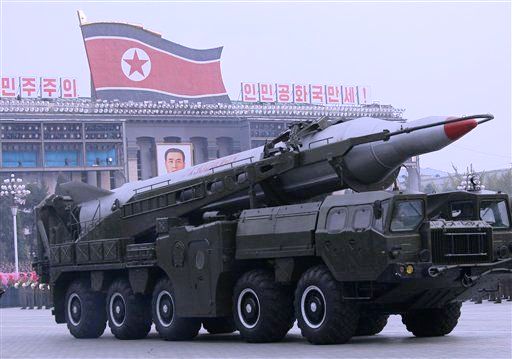
North Korea and the Nuclear Clock
As North Korean nuclear and missile technology advances, it becomes increasingly belligerent. The world cannot afford to wait for the problem to solve itself.
BY PETER LOFTUS
The regime in North Korea commenced 2016 with a series of provocative acts that are shocking even when compared to its own impressive record of unapologetic bellicosity. Bluster from above the 38th parallel isn’t anything new, but the recent scale, intensity, and increasing credibility of such threats should not be ignored.
 On Jan. 6, North Korea detonated what is believed to be a nuclear warhead with a booster that it claimed was a hydrogen bomb. In February, it launched a Taepodong-2 missile to carry a satellite into space, simultaneously demonstrating the capacity of this space-launch vehicle to serve as an inter-continental ballistic missile. More recently, the North Korean government stated that it may use a pre-emptive nuclear strike against the U.S. mainland and “liberate” South Korea. It also threatened to turn U.S. military bases in the region into “a sea of fire and heap of ashes” by pressing “the button.” Although North Korean threats are typically just bluster, their technological advancements make their threats increasingly plausible.
On Jan. 6, North Korea detonated what is believed to be a nuclear warhead with a booster that it claimed was a hydrogen bomb. In February, it launched a Taepodong-2 missile to carry a satellite into space, simultaneously demonstrating the capacity of this space-launch vehicle to serve as an inter-continental ballistic missile. More recently, the North Korean government stated that it may use a pre-emptive nuclear strike against the U.S. mainland and “liberate” South Korea. It also threatened to turn U.S. military bases in the region into “a sea of fire and heap of ashes” by pressing “the button.” Although North Korean threats are typically just bluster, their technological advancements make their threats increasingly plausible.
Since coming to office, South Korean President Park Geun-hye has made significant strides in advancing her country’s relations with Beijing—much to the chagrin of the United States and Japan. She has met with Chinese President Xi Jinping on six occasions, and was a notable attendee of the Chinese military parade in September 2015. However, any belief that leaning towards China might lead to progress on the North Korea issue seems to have receded. Recently, South Korea has been reviving its partnership with Japan and the United States, improving damaged relations with the former and bolstering its military alliance with the latter. This includes deployments of U.S. F-22s, B-52s, and nuclear submarines to South Korea, as well as an exercise that has included over 15,000 U.S. and 300,000 South Korean troops.
With respect to North Korea, China is stuck between a rock and a hard place. Since taking office President Xi has had a lukewarm relationship with the country. Although China is widely perceived to be North Korea’s “ally” or “friend”, it is as much a hostage of North Korea as South Korea and Japan. When being criticized for allowing North Korea to act irresponsibly, the Chinese often argue that if it weren’t for the U.S. military threat, the North Koreans wouldn’t have had to develop nuclear weapons in the first place. This does nothing to solve the problem at hand, and the truth goes a little beyond the threat of the U.S. military. An important consequence of acquiring a nuclear deterrent is that it has guaranteed Pyongyang a higher degree of autonomy from Beijing. Although China is North Korea’s primary trade partner and its economic lifeline, the Kim dynasty has never wanted to be a puppet government. As a nuclear power, North Korea is more difficult to manipulate, and Chinese policymakers are aware that North Korean missiles can hit Beijing as easily as they could hit Tokyo or Seoul.
In a recent article in Foreign Policy magazine, Jeffrey Lewis, a director at The James Martin Center for Nonproliferation Studies, argued that the U.S. strategy to deal with North Korea has failed. He asserts that for quite a while Washington’s policy on the North Korean nuclear issue has been adrift, and that, “we’re not managing the problem so much as managing our inability to manage the problem.” Beijing’s policy has been equally flawed. North Korea served as a buffer state and “ally” for half a century, but it is now an existential threat to Japan, South Korea, China itself, and increasingly the United States. Even Russia, one of the original belligerents in the Korean War, is criticizing North Korea, stating that the North’s threats of a pre-emptive nuclear strike could become legal grounds for the use of military force against the country. With 63 years of neglect, the United States, China, and Russia together allowed the Korean situation to degenerate into the current precarious state. It is now time to put aside perennial mistrust and work together on a bold and comprehensive plan to effectively deal with this problem. The South Koreans, Japanese, Russians, Chinese, and Americans must articulate a plan of action for how to deal with this issue (such as the denuclearization of the peninsula, regime change, etc.), and then decide how to work together to realize this objective. Pursuing separate agendas will not procure a peaceful solution on the Korean Peninsula.
Procrastination on this “forgotten war” has made the strategic calculus even more complex and the potential consequences far more severe. The current regime in North Korea benefits from the divisions and indecisiveness among its neighbors, and only through a completely unified stance can it be comprehensively confronted. Before we can even discuss how to solve the problem of North Korea, Beijing, Moscow, Washington, Tokyo, and Seoul must unify their rhetoric and actions. What is now required is leadership and a willingness to confront a hard truth: the North Korean problem will not solve itself, and the potential for a nuclear conflict increases daily. We cannot afford to keep kicking the nuclear can down the road.


